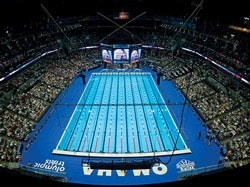For about three years, the 50-meter stainless steel competition pool used at the 2008 U.S. Olympic Swim Trials sat disassembled in an Omaha, Neb., storage facility, not far from where 16,000 swimming fans had jammed the Qwest Center and witnessed the setting of nine world and 21 American records. The pool's bottom and side panels were stacked on pallets, and all of the mechanical equipment was housed in a climate-controlled space.
Today, that iconic pool — manufactured by the Italian company Myrtha Pools in partnership with USA Swimming — has been reassembled, bolted together like a giant erector set and waterproofed with a PVC membrane floor. It is now the crown jewel of its permanent home, a 54,000-square-foot indoor aquatics facility in Richmond, Va., located adjacent to a 46-acre regional sports park with seven soccer fields.
 FROM HERE TO ETERNITY The competition pool used at the 2008 U.S. Olympic Swim Trials (above) is now a permanent fixture in a 54,000-square-foot facility operated by Virginia's Greater Richmond Aquatics Partnership (below). (Photo courtesy of USA Swimming)
FROM HERE TO ETERNITY The competition pool used at the 2008 U.S. Olympic Swim Trials (above) is now a permanent fixture in a 54,000-square-foot facility operated by Virginia's Greater Richmond Aquatics Partnership (below). (Photo courtesy of USA Swimming)
But when Poseidon's fundraising for the project fell short, the swim club joined forces with the other entities. Ground was broken in 2011 for the aquatic facility, which also includes mezzanine seating for 700 spectators, a six-lane 25-yard teaching pool and a 3,500-square-foot therapy pool (but not the warm-up pool; more on that later). The grand opening in March featured an appearance by Olympian Katie Hoff. A 4-by-2-foot panel from the pool, signed by all members of the 2008 U.S. Olympic swim team and encased in glass, hangs proudly in the lobby and serves as a reminder of the pool's history.
"The idea was to catalyze the city of Richmond around four key areas: water safety, sports tourism, competitive swimming, and health and wellness," says Adam Kennedy, GRAP's executive director. "The end result is a powerful social mission revolving around an aquatic center that grew in scope and size to be quite daunting. But it's a real neat place for competition, teaching and fitness. Plus, the idea that people can come in and touch a piece of the Olympics — and of that U.S. Olympic team with Michael Phelps on it — has been huge. It's something that makes people proud to say, 'This is where I swim.' "
"These days, fewer and fewer people are building pools on their own," says Stu Isaac, president of The Isaac Sports Group, an Ann Arbor, Mich.-based consulting company that works with communities to develop collaborative aquatics projects and has helped secure permanent homes for other high-profile temporary pools. "It's not necessarily just the city's pool or the school district's pool. Sometimes, the pool is inside a school district building located on parks and recreation land used by the local USA Swimming club, which is providing operating revenue, leading community support or overseeing a fundraising campaign. More of these public-private partnerships are happening."
Without a joint venture such as GRAP, it's safe to say that the aquatics scene in Richmond wouldn't be nearly as robust as it is today. Organizations in Massachusetts and Nebraska are working to develop similar regional swimming meccas using the competition and warm-up pools from the 2012 U.S. Olympic Trials, held in Omaha (again) from June 25 to July 2. And others are already lining up for a shot to purchase the pools that will be used at the 2016 U.S. Olympic Trials.
"One of the reasons we are partners with USA Swimming," says Erin Whitlock, director of business development for Myrtha Pools, which has a U.S. office in Sarasota, Fla., "is because of what we believe swimming does for a community."
The competition pool from the 2004 U.S. Olympic Trials in Long Beach, Calif., now resides at Crafton Hills College in Yucaipa, Calif., where it is used by students of the college, high school teams and private clubs. Similarly, the pool from the 2005 FINA World Championships in Montreal became the centerpiece of Florida State University's Morcom Aquatics Center.
Myrtha Pools typically starts marketing its turnkey packages with the pools it provides to USA Swimming and FINA events between 18 months and two years out from a given event, and both pools used at the 2012 Olympic Trials were sold before they even went inside Omaha's CenturyLink Center (as the Qwest Center is now known).
Granted, opportunities to obtain a temporary pool used at a major swimming event and then give it a permanent home don't surface often. But even with no major swimming events yet booked in the United States for the next four years, opportunities are out there.
Take, for example, the warm-up pool GRAP purchased after the 2008 U.S. Olympic Trials. Unable to incorporate it into their facility plans, officials put the pool on the market and were asking $900,000 for it as of this writing. "We knew we couldn't be everything to everyone, but we thought we could be something to a lot of people," Kennedy explains. "So we didn't need a 150,000-square-foot venue. Once you put two 50-meter pools side by side inside a building, the cost is considerable."
Isaac is overseeing the marketing of that unused warm-up pool and provides prospective buyers with information about the cost of configuring it to fit specific needs. "Really, what we're doing for these people is what more people should be taking seriously when doing any pool project: looking at what is needed to define goals and objectives, and then making sure the design matches those needs," he says. "I would emphasize getting broad-based involvement from all aquatics community stakeholders early on. Figure out your needs before taking a look at these Trials pools or other opportunities. Then develop a financial model to determine if you can make it a sustainable business venture."
Charles River Aquatics, primarily a learn-to-swim organization and competitive swim team that uses space at Boston University, bought the 2012 U.S. Olympic Trials' competition pool for a little more than $1 million and plans to build its own facility to house the new pool and provide more teaching, competitive training, aquatic fitness and Masters Swimming opportunities, as well as other water-based programming. As of this writing, CRA management is in discussions with several potential partners to provide a location.
"People at Charles River knew they had a business model that was viable," says Isaac, who worked with them to develop various options and encouraged them to go after the pool from Omaha. That model, which included proof of financial clout and sustainability, local support and a vision for the future, helped Charles River secure the Trials pool. And within weeks of sending out a press release last September announcing its acquisition, Isaac says CRA officials were setting up meetings with four or five different educational institutions and municipalities that were interested in becoming the pool's host site.
That's similar to what happened in Omaha, except officials with the Omaha Multisports Complex took a complete leap of faith — one actually based on no business plan — and were still lucky enough to secure the warm-up pool used at the 2012 Trials for the same price Charles River paid for the competition pool. "We decided we needed to figure out how to keep the warm-up pool in Omaha," says Lisa Roskens, chief executive officer of Burlington Capital Group and one of the chief fundraisers for a project that could eventually include multiple pools and tennis courts on a to-be-determined site. "When we hosted the Trials in 2008, there were quite a few people locally who were ready to buy the pool at that time. But they didn't have the land, so they didn't pull the trigger. We didn't want to miss out this time, because we didn't know whether we would get the Trials again. If we had taken the time to figure out a site, develop a needs assessment and do a feasibility analysis, we wouldn't have gotten the pool. There were other people looking to get it, and we knew it was going to get sold by the end of June. We wanted to make sure it was to us."
By year's end, Roskens hopes to have raised enough money to cover the remaining cost of the pool (as of late August, she was $300,000 short of her goal). Then a location needs to be determined. At least four potential sites have been in play, including the University of Nebraska at Omaha, a piece of school district property, land owned by a local YMCA and land located in a nearby municipality. "My instinct was, if we announced we have a giant piece of equipment and we want to build a large cash-flowing business on a piece of property, we wouldn't have a problem finding that property," she says. "And, literally, every real estate agent in the city who had a piece of property five acres or larger was calling me. So it was a little bit of the 'If you buy it, they will come' idea."
After the Omaha Multisports Complex names a site, partnerships and fundraising for the actual facility can begin in earnest. "Realistically, I can't start talking about the bigger fundraising project until I have the location," Roskens says, adding that she hopes to open the facility's doors in four years. "Our attitude is that once the pool's paid for, we want to get moving on the building project."
For now, the pool sits in the same storage facility that housed the 2008 Olympic Trials pool until GRAP was ready for it. "I don't think this was the only way an indoor pool would have happened in Omaha," Roskens concedes. "But I don't think it would have been as good, because something of the caliber of the Trials pool is not something we could have probably obtained otherwise. To be able to swim in the pool that helped send Michael Phelps to London to become the most decorated Olympian - there's something to be said for that. And that will be very much part of the marketing. But what appeals to Omaha is the idea of having an incredibly high-caliber facility that's available to everyone. It's not only for elite, highly competitive swimmers. The focus will be on producing champions, but it will be a community pool. It will be available to anyone who wants to use it."
Omaha's desire to retain one of the Trials pools from this year may be the start of new trend, according to Isaac. "Because there really is a dearth of big 50-meter pools in this country, a city that's bidding for a major swimming event may as part of its bid say, 'We want to keep one or both of these pools for permanent facilities within our community,' " he says. "So part of the bid going forward may include the guarantee of an already-selected permanent installation."
In addition to the two pools used at the 2012 U.S. Olympic Swim Trials, Myrtha installed seven of the nine pools at the 2012 Olympic Games in London. The temporary structures were in place for a little less than a year, Whitlock says, and all seven were sold to municipalities in the United Kingdom for permanent installation to bolster the Games' legacy.
A legacy is what Kennedy and other GRAP members are striving to create in Richmond. "The story of our pool is collaboration, and some of the potential buyers of our warm-up pool are starting to find out the same thing," he says. "People working together can make something like this happen. A big university might be able to put something like this in the ground if it wants to, but if you're talking about something that's going to have community-wide impact, it's going to take a lot of people working together from the region."
GRAP's aquatic center hosted more than 4,000 athletes and 8,000 spectators during a 20-day stretch of events between July 23 and Aug. 11, and a USA Swimming Zone Championships meet attracted 1,260 swimmers from states along the Eastern Seaboard. As of late August, it had booked local or regional events for 17 weekends through July 31, 2013, and Kennedy was expecting to add an estimated five more events to the facility's calendar. That still will leave plenty of weekends open for recreational use and allow Kennedy's staff of four full-time and 45 part-time employees to focus on creating partnerships with and swimming opportunities for Richmond's three public school districts, which claim only one high school swim team among them.
"Catalyzing competitive swimming and growing it at the high school level is definitely part of our focus, and that's hard to do in these tough economic times," Kennedy says. "It's tough to convince school districts to take on another sport. We talk to them all the time. It will happen; it will just take some time."
It's all part of that collaborative process, which should remain ongoing long after any aquatic facility fills its pools for the first time. "Clearly, the Olympic legacy is unique," Isaac concludes. "But much of what has been successful with the relocation of the Olympic Trials pools is also applicable to other projects — especially collaborative projects. Just as the Olympics raise the profile of swimming and aquatics every four years, these kinds of projects can help do that in a local community every day."




































